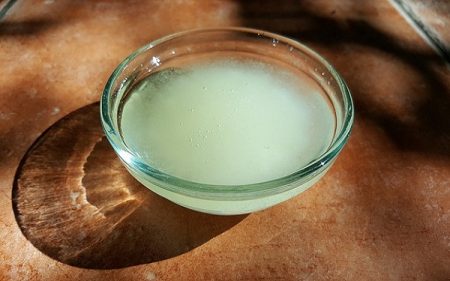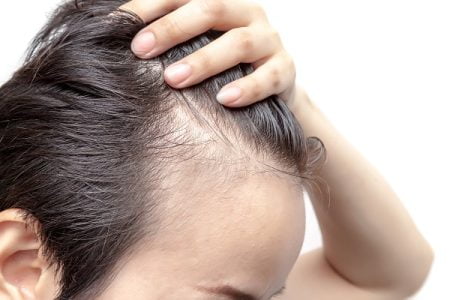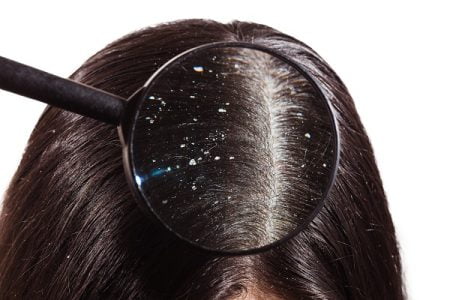What Is Ear Dandruff?
- Updated on: Jun 10, 2024
- 3 min Read
- Published on Mar 17, 2020

Definition of Dandruff
Dandruff is a scalp condition which causes excess flaking and shedding of skin. It may often lead to itching also. The exact cause of dandruff is still unknown but various factors may increase the risk of developing dandruff.
Dandruff can occur in scalp, face and inside or behind the ears.
What is Ear Dandruff?
Ear Dandruff refers to the appearance of dry, powdery or greasy flaking skin inside and around the ears. This may cause itching and sometimes inflammatory skin also.
Ear dandruff is the symptom of seborrheic dermatitis (a dandruff condition that leads to white to yellow flaky scales on oily areas like scalp, face or inside the ear).
What are the Causes and Risk Factors of Ear Dandruff?
The causes of ear dandruff include:
- Environmental and weather conditions. During hot and cold weather, skin usually becomes dry which may lead to dandruff.
- Oil gland activity in skin
- Fungal infection (Yeast like malassezia, which lives on skin, mainly in oil glands areas)
- Exposure to harsh soaps and cleansers might contribute to dryness.
Risk factors of ear dandruff include:
- Allergic reaction
- Sun exposure
- Dehydration
- Swimming in chlorinated pools
- Smoking
- Stressful condition
- Chronic health conditions
Ear dandruff is a critical problem as it causes blockage of ears and sometimes pain also. Another common cause of ear dandruff can be psoriasis.
People who use hearing aids may develop dry ears due to the device which rubs against the delicate skin in and around the ear.
What are the Treatments to Get Rid of Ear Dandruff?
Treating for dry ears would ultimately result in ear dandruff treatment. Some commonly recommended treatments are:
Moisturization
Ear dandruff can be treated with ointments, creams, or lotions.
- Ointments consist of a mixture of water in oil, like patrolium or lanolin. They protect the skin layer. Antifungal ointments can also be helpful in the treatment of ear dandruff.
- Creams contain oils and its main ingredient is water. They need to be applied more often. Mild steroid creams can be used to treat this condition.
- Lotions are mostly water mixed with powder crystals, which feel cooler in skin. Lotions can be applied more frequently to relieve from dandruff. These products must be taken after a doctor’s prescription.
- Doctors might prescribe antifungal ointment or lotion containing product with 2 percent ketoconazole (Nizoral) or 1 percent ciclopirox. These products can be used to treat ear dandruff. It would be best to apply these products after bathing and toweling off.
Change personal products
It would be good to switch your products to gentle personal care items. Using mild soaps and shampoos won’t dry out the skin.
Combat itching
Itching can be due to dandruff in and around the ear. Itching leads to the invasion of bacteria in the skin and causes skin infection also.
Use a cool compress on the ears when itching starts.
Creams with hydrocortisone, fluocinolone (Capex, Synalar), clobetasol (Clobex, Cormax) and desonide (Desowen, Desonate) can help in reducing inflammation in the skin.
Other popular methods
- Ear drops combined with anti-inflammatory ointments can be useful in treating ear dandruff
- Avoid nickel containing jwellery, if you find them allergic. This will support overall treatment.
- Washing ears with dandruff shampoo can be useful in getting rid of the ear dandruff. Recommended shampoos for this purpose are tar-based shampoos, selenium sulfide shampoos, and zinc pyrithione shampoos.
FAQs
What Causes dry Flaky Skin in Ears?
Dry, dead skin flakes and itchiness in the ear canal leads to dry ears. It may be caused due to not being able to produce enough earwax or due to cleaning of the ears too much. Dry ears can also be linked to skin allergies, ear dandruff and to other dry skin conditions such as eczema, psoriasis, and dermatitis.
Can you use Hydrocortisone Cream in Your ear?
Corticosteroids (1% hydrocortisone cream or a more potent betamethasone cream) can decrease inflammation and itching in the ear. Patients should avoid using water, cotton swabs, and other potential irritants in the ear, because these will aggravate the inflammatory process.
What Foods Trigger Seborrheic Dermatitis?
Some common foods that can trigger an seborrheic dermatitis flare-up and could be removed from a diet include: citrus fruits, dairy, eggs, gluten or wheat, spices, such as vanilla, cloves, and cinnamon. Tomatoes and some types of nuts can also trigger dermatitis.
How do you get rid of Dandruff in Your ear?
For ear dandruff, washing the areas with a dandruff shampoo may be very helpful. Avoid heavily oiled hair and skin products. Avoid caps that close ears, fitted hats, head wraps, or helmets. Moisturizers should be used after bathing and toweling off.
Can ear wax Cause Itching?
Generally, earwax provides an effective shield against outer ear infections, but it can be a cause of itchiness. If the body generates too much earwax, it can block the ear canal, leading to irritation. Sometimes, itching in the ear can arise from an allergic reaction also.











